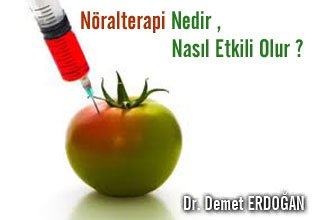
Neural therapy, two brothers, a medical doctor named “Huneke” in the 1920s, wanted to reuse a method that was used but was forgotten in one of their patients, and when it got good results, they developed it. has come to the fore again.
In order to regulate the body. It is a treatment with local anesthetic injection to certain points or areas. The perfect organization of the vegetative nervous system, which surrounds the body with a very wide network, plays a very important role in the creation of this regulation, and its mechanism of action is explained through this system. The vegetative (autonomic) nervous system is in a very wide electrical network structure in our body. This system consists of two different parts called the sympathetic and parasympathetic systems, which are different from each other but work in harmony with each other.
The VSS or neurovegetative system controls all vital activities in our body; It is responsible for providing respiration, circulation, digestion, hormonal regulation, regulation of metabolism, in short, “homeostasis” (internal balance).
Neuro-Vegetative system records all kinds of stimulus in its memory and if the body cannot cope with this problem, it causes various complaints in the body for years. Every part of the body has connections due to the reflex pathways formed through this system. All neurovegetative system functions occur as a result of adjustments between cellular, neural and hormonal regulatory mechanisms.
Any disruption in only one of these mechanisms will result in functional disorder of the whole system over time, if the body has not been able to cope with it. In other words, the disease will affect not only one organ, but the whole body
The fact that the recovery occurs within seconds after the application of Local Anesthetic to certain points in the body for treatment, that is, the appearance of the local anesthetic into the blood and long before its absorption, shows us the presence of electrical communication in the system. Only the Vegetative Nervous System can carry out such a rapid transmission, and this is more of a physical than a chemical effect. Vegetative Nervous System fibers 500,000 km. It has a long network and functions with 25 billion nerve cells. For this reason, it is possible to solve the problems that have not been solved for years by the regulation of the vegetative nervous system.
Injections with local anesthetic into defective segmental tissue produce two important effects. It eliminates pathological reflex pathways and also serves to normalize vegetative functions by repolarizing the damaged cell membrane to the correct potential.
Segment Therapy, which is an important part of Neural Therapy, concerns not only the Dermatome but also the structures at that level such as Visserotoma, Myotome, and Osteotome. The stimulus reaches the organ associated with the respective segment from the periphery via the spinal cord, or from the organ to the spinal cord. reaches the other organ. Any disorder that will occur in only one of these formations will result in functional dysregulation in other systems. And this warning will not only be limited to that segment, but will also reach further segments.
Various pathological stimuli affect the sympathetic nerve fibers, not the cell or cell wall. Perivascular sympathetic fibers are particularly important here. Changes begin in the VSS and lymphatic circulation before the disease manifests itself. Changes occur in the Basic Substance, which consists of intercellular connective tissue and extracellular fluid, and the first pathological changes begin in the free nerve endings and structures such as proteoglycan, connectin, and elastin here. These findings were developed by Pischinger and later by H. Heine and named as “Grund System Theory”.
The reaction and regulation capacity of today’s people is constantly changing. Stress, electro smog, unbalanced nutrition, lack of physical activity, factors that impair the environment and quality of life and geopathogenic disorders, heavy metals, food additives, etc. They are factors that facilitate the formation of disruptive foci or disruptive areas. The immune system of the individual has an important role in the emergence of disruptive areas or foci. Changing environmental conditions affect all living organisms at the same rate, and as a result, an increase in resistance to known treatments occurs. According to studies, the rate of diseases caused by Disruptive Fields is around 30% today.
History is very important in neural therapy. When taking the patient’s anamnesis, it is very important to establish a temporal connection between the onset of the complaints and the various events experienced by the patient, the diseases he had and surgical interventions. Therefore, a comprehensive anamnesis should be taken and noted. Later, when the physical examination is started, the examination can be directed according to the characteristics of the anamnesis. During the examination, it may be necessary to deepen the anamnesis. As a result of these observations, treatment is started, but if there is no improvement in the patient’s condition after a few sessions, the anamnesis and examination are returned and a possible interference field is searched. In this context, it should not be forgotten that the tooth-jaw complex, tonsils and sinuses, which are responsible for most of the disruptive areas.
Having a healthy Neurovegetative system is equivalent to a healthy and quality life. Neural therapy protocols applied before diseases occur will positively affect the health of not only organs but also cells. Therefore, Neural Therapy is also the most important element of Preventive Medicine. The secret of a long and healthy life is the protection of health.
Demet Erdogan

